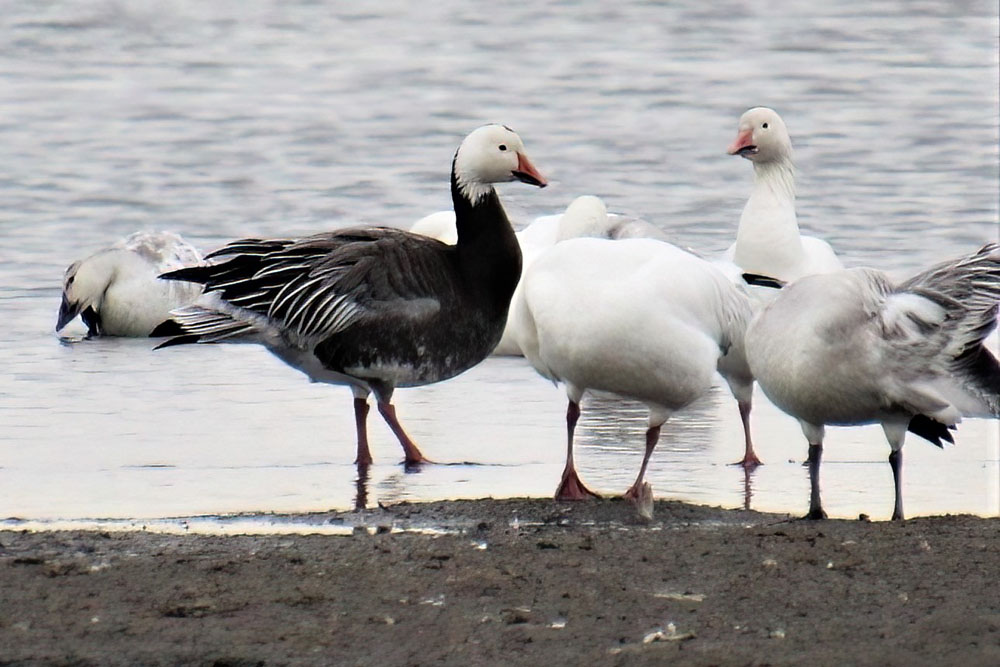With the level of Chestermere Lake lowered until next spring, more shoreline is exposed opening up opportunities for a variety of waterfowl species to stop, rest, find food and connect with smaller flocks of the same species. As a result local bird watchers, lakeside residents and those living near Chestermere, have been treated to an aerial display that is difficult to rival. Over the past few weeks, Elaine and I have been enjoying the potpourri of ducks, geese and swans that have spent time on the water, sat on the shorelines, slid on the ice and enjoyed nourishment in the fields east of Sunset Beach.
Elaine has dedicated several hours to sitting along the shorelines on the east side of the lake, hoping to catch the ideal photographs of the snow geese, trumpeter swan and the tundra swan. After nesting and raising young in the high Arctic, snow geese are ready to begin migrating as early as September. Flocks can range from hundreds into the tens of thousands, blanketing water bodies and open fields.
Using North America’s four main flyways, snow geese will fly great distances and then spend a significant amount of time at key stopovers to rest, feed and prepare for the next leg of the flight to the United States Gulf Coast. You may see snow geese that are a different color, other than the classic white. Commonly called the “blue morph”, this snow goose has a predominantly blue body with a white head – certainly a visual surprise in a field of white snow geese.
Like the snow goose, the tundra swan creates the next generation of swans in the high Arctic landscape. Still called “whistling swans” by some birdwatchers, due to the sound created by the wings and its calls, the swan lives the life of romance we associate with swans. By the time they are 3 years old tundra swans pair up and stay together year round. This pairing can last a long time, with one of the oldest Tundra swans aging to over 23 years. Tundra swans, while stopping at Chestermere Lake, are likely headed to California for the winter.
Similar in appearance to the tundra swan is the magnificent trumpeter swan. The trumpeter swan is notably larger than the tundra swan, stretching to a length of 6 feet and weighing over 25 pounds. With such a huge mass, an open water runway of over 100 yards is needed to generate the speed needed for life off. Near extinction at one time, the trumpeter makes parts of central and northwestern Alberta locations for creating the next generation.
Trumpeters will normally head to the ice-free water of the British Columbia;s west coast and state of Washington to over winter. As the tundra and trumpeter swans look very similar, there are a few notable differences to help anyone identify each kind of swan. Aside from the size differences, the trumpeter almost always has a solid black bill, that is straight in shape.
You may also see a reddish “lipstick” marking where the upper and lower bills meet. Tundra swans usually have yellow markings below the eyes that vary in size. Tundra swans beaks tend to be curved and concave in shape. Another difference is the call and voice of each species. The trumpeter lives up to its name sake, while the call of the tundra is usually a higher pitch and different cadence.
Aside from these 3 amazing migrators, Chestermere Lake provides a resting place and food source for several species of ducks as well as shorebirds such as the killdeer and the greater yellow legs. Last but not least of course are the thousands of Canada Geese, accompanied with the much smaller Cackling Goose, filling the skies multiple times leaving the lake for nearby fields, then to return for a safe resting place. Living in Chestermere provides anyone who loves nature the opportunity to celebrate and note the changing of the seasons with our magnificent migration. .







